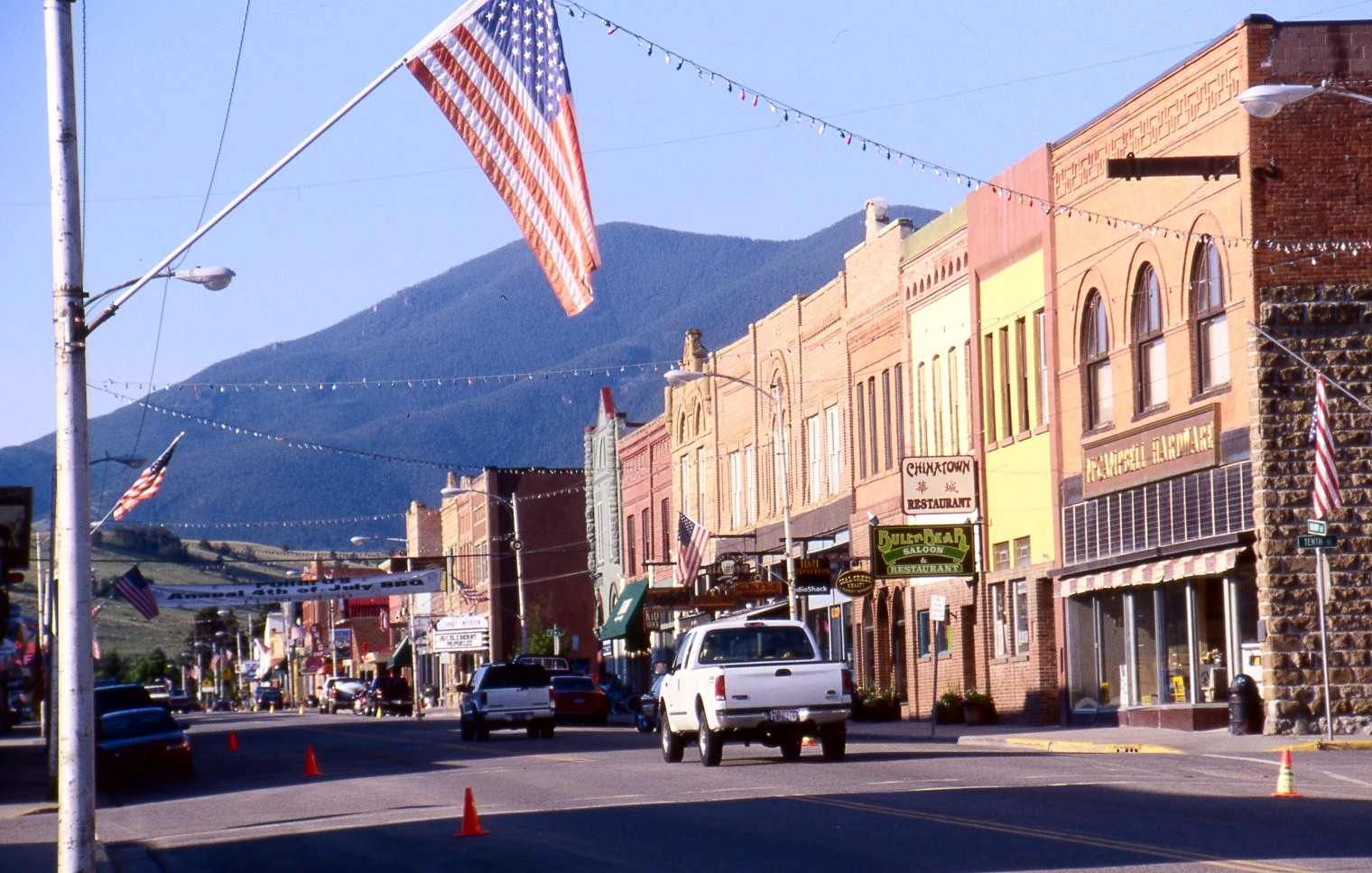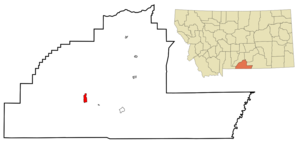- Red Lodge, Montana
Infobox Settlement
official_name = Red Lodge, Montana
settlement_type =City
nickname =
motto =
imagesize = 250px
image_caption = Main Street in Red Lodge
image_
image_
mapsize = 250px
map_caption = Location of Red Lodge, Montana
mapsize1 =
map_caption1 =subdivision_type = Country
subdivision_name =United States
subdivision_type1 = State
subdivision_name1 =Montana
subdivision_type2 = County
subdivision_name2 = Carbon
government_footnotes =
government_type =
leader_title =
leader_name =
leader_title1 =
leader_name1 =
established_title =
established_date =unit_pref = Imperial
area_footnotes =
area_magnitude =
area_total_km2 = 6.7
area_land_km2 = 6.7
area_water_km2 = 0.0
area_total_sq_mi = 2.6
area_land_sq_mi = 2.6
area_water_sq_mi = 0.0population_as_of = 2000
population_footnotes =
population_total = 2177
population_density_km2 = 326.6
population_density_sq_mi = 846.0timezone = Mountain (MST)
utc_offset = -7
timezone_DST = MDT
utc_offset_DST = -6
elevation_footnotes =
elevation_m = 1697
elevation_ft = 5568
latd = 45 |latm = 11 |lats = 15 |latNS = N
longd = 109 |longm = 14 |longs = 55 |longEW = Wpostal_code_type =
ZIP code
postal_code = 59068
area_code = 406
blank_name = FIPS code
blank_info = 30-61525
blank1_name = GNIS feature ID
blank1_info = 0789456
website =
footnotes =Red Lodge is a city in and the
county seat of Carbon County,Montana ,United States .GR|6 It is part of theBillings, Montana Metropolitan Statistical Area . The population was 2,177 at the 2000 census.Geography
Red Lodge is located at coor dms|45|11|15|N|109|14|55|W|city (45.187515, -109.248475).GR|1
According to the
United States Census Bureau , the city has a total area of 2.6square mile s (6.7km² ), all of it land.History
Red Lodge first achieved importance with the discovery of
coal in the middle of the 19th century. This was especially important because theNorthern Pacific Railroad needed coal to fuel their steam engines. In the late 1800s, many new settlers came to Red Lodge. Some of the records show that these include people fromItaly ,Scotland ,Wales ,England ,Finland ,Norway ,Sweden andAustria-Hungary . By the mid 1880s, migrants were still outnumbered by large numbers of Native Americans. By 1892 the population reached 1,180.In 1896, Red Lodge had twenty saloons and, as the library records show, riotous and violent living was characteristic of the town. By 1906 the population had grown to 4,000 and by 1911 this had increased to 5,000.
Red Lodge suffered in the
Great Depression , which forced many mines to close. To offset this downturn, the manufacture of illegal bootleg liquor, labeled syrup, became an economic mainstay and was sold as far afield asChicago and San Francisco.In 1931 work began on the
Beartooth Highway linking Red Lodge toYellowstone National Park , and it was officially opened in 1936.In the 1990s, this area became the subject of famed southwestern artist Earl Biss' work, "Red Lodge with the Melting of the Spring Snow".
Outdoor recreation
Red Lodge is well known for many outdoor recreation opportunities: Skiing, Mountain Biking and backpacking are nearby. In April it is host to a popular triathlon called the Peaks to Prairie.
Notable residents
*John "Liver-Eating" Johnston, the first lawman in Red Lodge.
*Harry Longabaugh (a.k.a. the Sundance Kid) and George Curry (a.k.a. Kid Curry) were captured in Red Lodge on September 18th, 1897 after attempting a bank robbery, but escaped with help from the rest of theWild Bunch gang
*The guest register at the Pollard Hotel shows that Martha Jane Cannary-Burke (a.k.a. Calamity Jane) stayed there.
*Laurie Niemi ,Washington Redskins offensive tackle , was born here.
*K. Ross Toole , noted Montana historian, retired to Montana to operate a ranch near here.
*Brady Canfield ,Bronze medal winner in the 2003 FIBT World Championships in skeleton racing, was born here.mith Mine disaster
In 1943 tragedy hit Smith Mine #3 near Bearcreek, the area's largest remaining mine. An explosion trapped and killed 74 men - only three of the workers that were in the mine that day escaped. This was the worst coal mine disaster in Montana's history. The mines were shut down forever shortly thereafter. The Red Lodge cemetery contains a memorial.
Demographics
As of the
census GR|2 of 2000, there were 2,177 people, 1,020 households, and 528 families residing in the city. Thepopulation density was 846.0 people per square mile (327.1/km²). There were 1,415 housing units at an average density of 549.9/sq mi (212.6/km²). The racial makeup of the city was 96.14% White, 0.41% African American, 1.10% Native American, 0.46% Asian, 0.46% from other races, and 1.42% from two or more races. Hispanic or Latino of any race were 1.98% of the population.There were 1,020 households out of which 22.8% had children under the age of 18 living with them, 41.3% were married couples living together, 7.3% had a female householder with no husband present, and 48.2% were non-families. 39.8% of all households were made up of individuals and 15.0% had someone living alone who was 65 years of age or older. The average household size was 2.04 and the average family size was 2.76.
In the city the population was spread out with 20.2% under the age of 18, 6.9% from 18 to 24, 28.6% from 25 to 44, 24.9% from 45 to 64, and 19.4% who were 65 years of age or older. The median age was 42 years. For every 100 females there were 93.5 males. For every 100 females age 18 and over, there were 88.9 males.
The median income for a household in the city was $31,750, and the median income for a family was $40,260. Males had a median income of $30,250 versus $20,208 for females. The
per capita income for the city was $19,090. About 6.9% of families and 9.7% of the population were below thepoverty line , including 12.4% of those under age 18 and 9.3% of those age 65 or over.chools
Red Lodge is served by three schools: Mountain View Elementary School, Roosevelt Middle School, and
Red Lodge High School .References
External links
Wikimedia Foundation. 2010.



